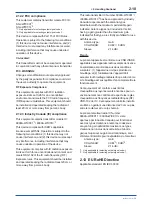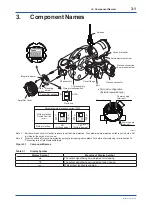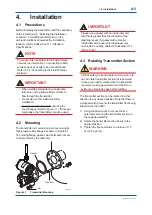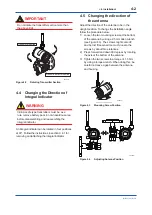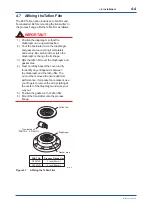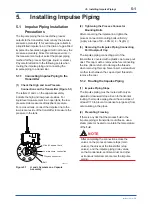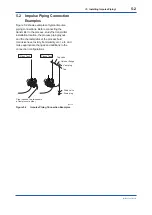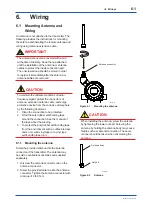
<2. Handling Cautions>
2-4
IM 01C27C01-01EN
4) Turn ON the insulation tester power and
measure the insulation resistance. The voltage
should be applied as briefly as possible to verify
that the insulation resistance is at least 20 MΩ.
5) After completing the test and being very careful
not to touch exposed conductors disconnect the
insulation tester and connect a 100 kΩ resistor
between the grounding terminal and the short-
circuiting battery connection terminals. Leave
this resistor connected at least one second to
discharge any static potential. Do not touch the
terminals while it is discharging.
NOTE
When storing the instrument with a battery
pack, it is recommended to put the instrument in
Deep Sleep mode to conserve the batteries. For
details on how to switch to Deep Sleep mode,
refer to subsection 8.3.13 “Switching to Deep
Sleep Mode”.
• Dielectric Strength Test
1) Remove the battery pack or power supply
module. See subsection 9.4.5 Replacing the
Battery Pack or 9.4.8 Replacing the Power
Supply Module.
2) Short-circuit the battery connection terminals in
the terminal box.
3) Turn OFF the dielectric strength tester. Then
connect the tester between the shorted battery
connection terminals and the grounding
terminal. Be sure to connect the grounding lead
of the dielectric strength tester to the ground
terminal.
4) Set the current limit on the dielectric strength
tester to 0.1 mA, then turn ON the power and
gradually increase the test voltage from ‘0’ to
the specified voltage.
5) When the specified voltage is reached, hold it
for one minute.
6) After completing this test, slowly decrease the
voltage to avoid any voltage surges.
NOTE
When storing the instrument with a battery
pack, it is recommended to put the instrument in
Deep Sleep mode to conserve the batteries. For
details on how to switch to Deep Sleep mode,
refer to subsection 8.3.13 “Switching to Deep
Sleep Mode”.
2.8 Installation of an Explosion-
Protected Instrument
If a customer makes a repair or modification to an
intrinsically safe instrument and the instrument is
not restored to its original condition, its intrinsically
safe construction may be compromised and the
instrument may be hazardous to operate. Please
contact Yokogawa before making any repair or
modification to an instrument.
CAUTION
This instrument has been tested and certified
as being intrinsically safe. Please note that
severe restrictions apply to this instrument’s
construction, installation, external wiring,
maintenance and repair. A failure to abide by
these restrictions could make the instrument a
hazard to operate.
WARNING
The battery pack may be replaced in a
hazardous area. The battery pack has
surface resistivity greater than 1G ohm and
must be properly installed in the enclosure
of the transmitter. Care must be taken during
transportation to and from the point of installation
to prevent electrostatic charge build-up.



















